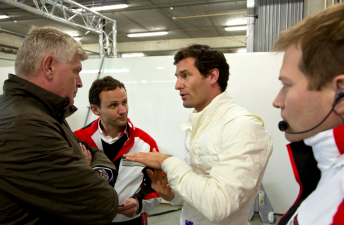

Mark Webber is enjoying an extended off-season this year as he prepares for his first year in the World Endurance Championship.
In this Q&A issued by his press office, Webber discusses his Christmas, his first test in the Porsche LMP1 last December and his training plans ahead of Silverstone’s season opener in April.
QUESTION: For the first time in a while you didn’t go back to Australia but instead you spent Christmas in Europe. What have you been up to?
MARK WEBBER: I was still quite busy for most of December, doing a fair bit of media, saying goodbye to everyone at the RBR factory and starting on my new programme with Porsche, so it really made sense to spend Christmas in the UK this time.
I actually really enjoy northern hemisphere Christmases and all the build up to them. The festivities give it a very traditional feel; it’s hard to replicate that in Australia because Christmas falls in the heat of summer when most families head to the beach so it’s just very different.
It was a shame in some ways we didn’t get any snow in England this Christmas as we had friends over from Australia but even so they enjoyed the frosty mornings and sitting in front of a roaring log fire in the evenings with a few glasses of red wine.
Last year we were in Fiji for New Year; this time we went to Scotland to welcome 2014 in. I have to say Hogmanay was one of the best NYE’s I’ve experienced in terms of atmosphere, with everyone joining in and being super friendly.
We took part in the traditional torchlight procession through the streets on the 30th – 35,000 people with probably half of them carrying flame-lit torches and walking 1.5kms through the city was just great fun.
Then, for Hogmanay we went to the street party and concert and watched the fireworks over the castle which was amazing.
QUESTION: Your new season with Porsche will start soon. In F1 the focus of your training was on the neck strength and being as light as possible, how does your training change for the sports car series?
WEBBER: This is my first season for probably five or six years when I haven’t needed to be on weight by February! Even though we will be doing some pre-season testing with Porsche, the preparation for F1 was different; I had to be on weight right from the start of pre-season testing and my weight control had to be extremely disciplined.
But, don’t think for one moment I’m going to be overweight in sports cars! I’ll be back at my F1 weight for the start of the championship in April but the WEC season is much shorter with only eight races, so I don’t need to be in that tight weight window for as long as I was in F1.
My training regime has changed a bit too; you do quite a lot of specific training for F1; for example, neck training to deal with the high G-forces whereas in sports cars because the lap times are a bit slower, I won’t quite have the load on the body that I used to.
Of course, there are lots of things from my training in F1 which are completely adaptable in sports cars, i.e. heat control in hot environments as was the case at some races in Formula One so there are a lot of things I learnt in F1 which I will carry across.

QUESTION: The races will last considerably longer for you now, how do you prepare for the endurance aspect?
WEBBER: The driving position is different to F1 cars, you’re laying down a lot more in an F1 car whereas in the sports car I am sitting a bit more upright. That means I’m using different muscles in my back, other muscles which I found out I need to use a little bit differently and muscles that I’m over trained for in the sports car.
From an endurance aspect, the seating position has to be as comfortable as possible because I could do some very long stints. If I’m asked to do a three hour stint I need to make sure I’m not getting pins and needles or the back of my legs are falling asleep.
I need to be comfortable in that environment but I also have to be mindful that I am sharing the car with other drivers so we have to compromise to a degree. We need to do quick pit stops and driver changes so we can’t afford to faff around making adjustments in the pits.
In terms of the endurance I think that it will be more mentally than physically demanding. Concentration levels will be paramount, obviously in terms of passing backmarkers and things like that.
Physically it will probably be less demanding than what I was used to but mentally it will be equally as demanding just because of the amount of traffic management you have to do for a long period of time.
QUESTION: The first time you’ve been in the car was in December, how did you feel?
WEBBER: I was really pleasantly surprised. I went in there keeping my expectations low in terms of what the car might feel like. It’s a lot heavier than an F1 car and very light on downforce so I thought perhaps the car wouldn’t respond that well compared to what I’ve been used to.
So I was really surprised, I knew within five or six laps that I was enjoying what I was doing which was great. I had Tom Kristensen and Allan McNish in my ears because they’ve been telling me for quite a few years that if I was thinking of making the shift to sports cars, they were still very nice cars to drive.
I believed them but it’s not until you actually do it yourself that you find out just how nice they are. I hadn’t driven one since 1999.
I did my first test on a circuit in Portugal which I hadn’t been to before, and it was a beautiful circuit to drive the car for the first time. It was very responsive and predictable.
It’s nice to be back on the Michelin tyres too; I had a good feeling on them. It was the first test and obviously there is still work to do, you never stop learning but it was a nice start and I left there buzzing which was great.”
QUESTION: How would you describe the difference of today’s cars to when you last drove in 1999?
WEBBER: The biggest difference is that we didn’t have any electrical or hybrid systems on the cars back in the late 90s, it was more old-school racing.
The gear stick was located away from the steering wheel and all sorts of things, whereas now the car is more like an F1 car but with a roof.
They’re highly technically advanced these days and you can see there’s been a huge carry over from Formula 1 technology during the 2000s into this category. That’s why the cars are so quick and the closest category to F1 in terms of lap time and pace.
QUESTION: What’s your schedule like in the upcoming weeks?
WEBBER: This year I’m having a bit of an offset break and a belated trip back to Australia. I’m looking forward to getting a bit of sun on my back, getting into the ocean and catching up with my family and friends.
Hopefully I’ll get the chance to do some heli flying too and for the first time I’ll be attending the Australian Open grand slam in Melbourne which I’m really looking forward to.





















